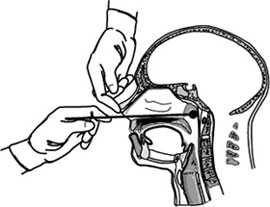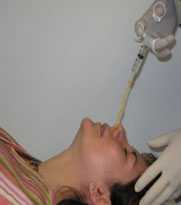Specimen Collection
Determining who has pertussis can be difficult. Whenever possible, clinicians should obtain a nasopharyngeal (NP) swab or aspirate from all persons with suspected cases. A properly obtained NP swab or aspirate is essential for optimal results (see Figures 1 & 2).
If culture is planned, once an NP swab has been collected it should be directly plated or immediately placed into transport medium. Laboratory scientists should plate NP swabs and aspirates within 24 hours of collection. The same specimen can be used both for culture and polymerase chain reaction (PCR). With PCR, the most rapid test, the specimen should ideally be collected during the first 3 weeks of illness, but may provide accurate results for up to 4 weeks. Culture has better specificity, but takes up to 7 days to obtain results. Also, clinicians ideally need to collect the specimen during the first 2 weeks of illness.
Pertussis Testing Video: Collecting a Nasopharyngeal Swab Clinical Specimen
Pertussis Testing Video: Collecting a Nasopharyngeal Aspirate Clinical Specimen
- Page last reviewed: August 7, 2017
- Page last updated: August 7, 2017
- Content source:




 ShareCompartir
ShareCompartir


